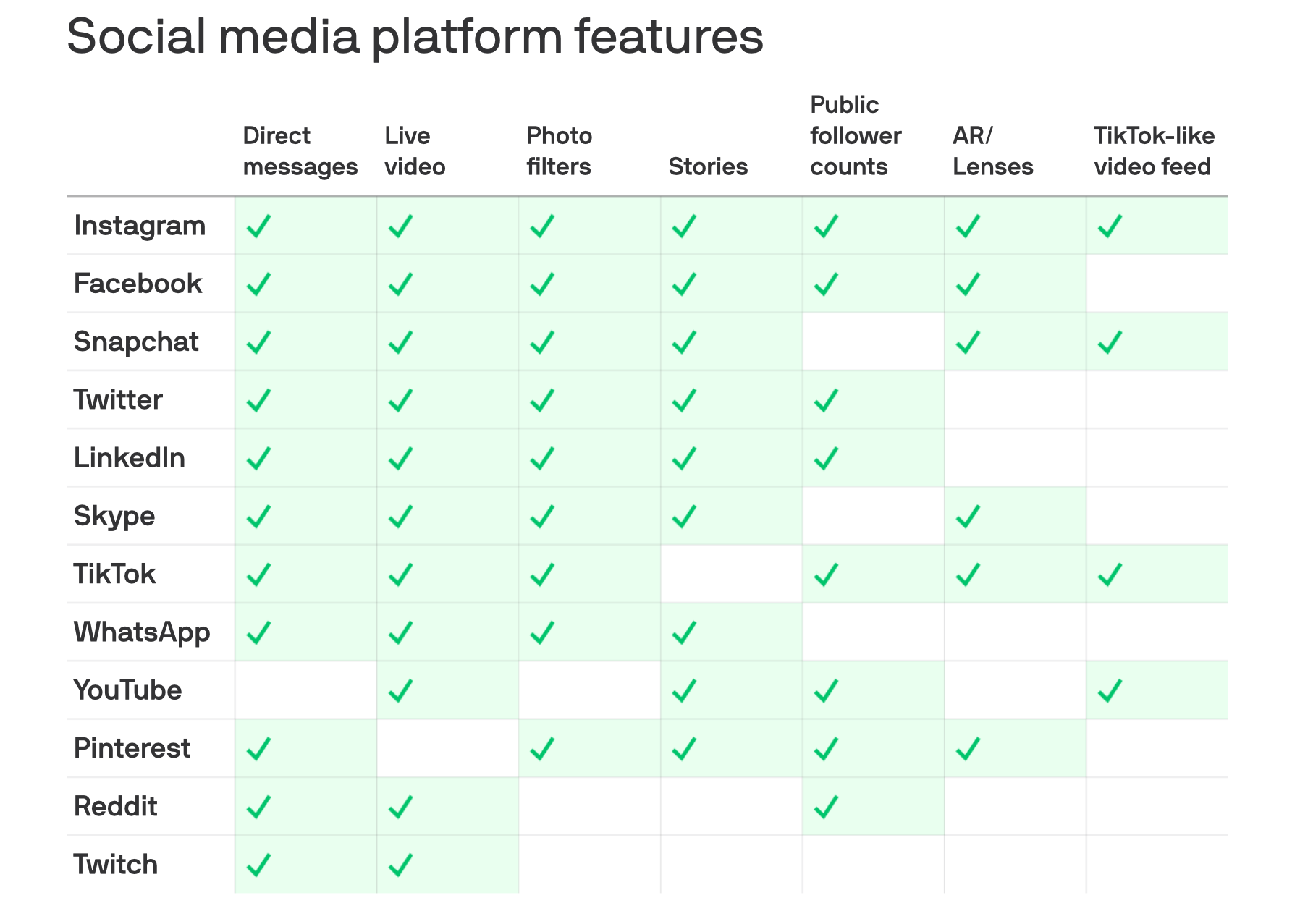Attack of the clones: all social networks are NOT becoming the same
Yes, all social networks are developing the same feature set. No, that doesn’t mean they’re all becoming the same. Here’s why.

It’s been quite a few weeks for cloning. Twitter cloned the Stories format into Fleets (which I actually quite enjoy), while Snapchat is cloning TikTok-style functionality into its product. Oh, and Spotify is also cloning Stories, following Instagram and LinkedIn.
As John Gruber put it, Stories are this “year’s featuritis fad”.
Stories, as a format, was launched by Snapchat back in 2013. It’s a form that has taken a long time to reach ubiquity. Three years elapsed before Instagram cloned it, and it’s taken another four years to reach fad status.
The broader accusation, though, though is that all social networks are becoming the same. Axios summed it up with this chart:

And at first glance, they do appear to be all gravitating towards a single set of functions. Maybe all the social networks are becoming the same.
The Functional Fallacy
WIRED made the same argument:
Companies are always eyeing their competitors to see what works; that’s just market research. But copycatting on social media has led to platforms that look suspiciously similar, with fewer things that set them apart. It’s harder to know what any given platform is for when they all do the same thing.
There’s only one problem with this idea, though, and it’s that a set of functional characteristic inherently determines the tone and texture of the product. This is a very tech way of viewing social networks: as a set of functionality.
I have a good example of why that’s not the case, one that many of you might be familiar with: magazines.
Magazines all look the same!
I mean, c’mon, look at them: folded paper, stuck together, under some sort of cover. Usually, they have short stuff near the beginning and the end of the issue, and longer stuff in the middle. They have some sort of listing of contents, and some adverts, and maybe letters from my readers.
Oh. My. Goodness.
ALL MAGAZINES ARE THE SAME.
Except, well, they’re not, are they?
The tone, the writers, the audience, and the style of content all add up to make radically different products within the same functionality set. Some estimates suggest that between 30% and 40% of the web is running on WordPress — but that homogenous functionality set doesn’t make all those websites the identical.
And the same will apply to the social networks: what will determine their character is now not the functions, but the experience. And the experience is determined by… the community.
Facebook cloned Livejournal
People often forget that the earliest versions of Facebook were, essentially, a simplified riff on Livejournal — the blogging platform I started on, and where Mark Zuckerberg was a user. It wasn’t the “friendship” functionality that made Facebook successful. Livejournal had exactly the same functionality -— and, in fact, had a newsfeed (its Friends Page) before Facebook did.
No, what made the difference was the community that Zuckerberg launched against: his university. And then other Ivy League universities. He built it progressively through circles of exclusivity that develop tightly interlinked communities, bringing the network effect into play.
So, yes, the standard feature set of social networks is developing nicely. The platforms are converging on a broad set of mutual features. They are converging in the same way that page layout software and content management systems have tended to converge. And so, those features cease to define the platform: the users those platforms serve and the things they build do.
And you know that already, don’t you?
The Social Network is defined by the Networks it attracts
Twitter is where those obsessed by journalism and politics hang out. Instagram is where people go to show off their lifestyles and (occasionally) creativity. TikTok is where people do creative, fun things to music. Facebook is where you get to hang out with your old school friends, your racist uncle and the mad variety of your geographically local community in one place.
Of course there's more to each of those platforms than that. Each of them has communities plural, not a single user base. The competition to host and keeping hosting them is where the next battle begins, as the networks begin to reach user saturation point.
As the platforms converge, cultivating the community they want to attract is going to become key to their survival. Cloning features is, essentially, a protectionist move, trying to reduce the reasons that people feel the need to go elsewhere for the compelling new sharing tools. Every time they do that, they run the risk of taking their network with them.
Now functional cloning is established as a default behaviour in the social space, we’ll see the true battleground emerging in managing and preserving the communities that live on those platforms.
This is the social platforms maturing into a limited number of highly competitive large organisations. This is the end of the beginning.





